Biggleswade, Bedfordshire
Up to 1834
In 1725, the SPCK's An Account of Several Workhouses... mentions the existence of parish workhouses in Biggleswade and Shefford Cum Compton. A Parliamentary Report of 1776-7 lists workhouses in Biggleswade (for up to 50 inmates), Dunton (20), Henlow (26), Old Warden (20), Potton (20), Sandy (20), and Southill (35).
A parish workhouse was in operation at Brigham House, 93 High Street, Biggleswade from about 1780, although the building itself is probably older. In 1837, the premises were sold off to George Newberry. The building is now occupied by accountants George Hay & Co.
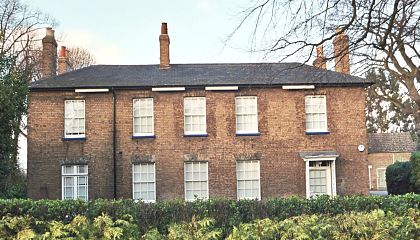
Biggleswade former parish workhouse, 2003.
© Peter Higginbotham.
In 1801, a workhouse at Langford was said to be barely fit for human habitation and a "cruel and oppressive" regime existed (Page, 1908). In 1803, poorhouses at Stotfold lacked proper floors and windows and the ill-clothed inmates were "unprovided with bedding of any description, and totally destitute of all furniture or necessary articles for the preparation of their food. A similar situation existed at Arlesey.
A building, now four cottages, on Southill High Street, is thought to be a former parish workhouse.
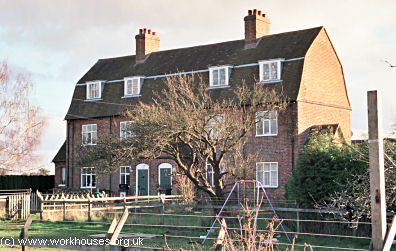
Southill former parish workhouse?, 2003.
© Peter Higginbotham.
After 1834
The Assistant Poor Law Commissioner assigned to Bedfordshire, Daniel Adey, had originally wanted to create a large union of 101 parishes centred on Bedford, and making use of Bedford's existing large and efficient workhouse. However, there was strong resistance from local estate owners who much preferred smaller unions where they exert more influnece. As a result, four smaller unions were created at Bedford, Ampthill, Biggleswade, and Leighton Buzzard.
The Biggleswade Poor Law Union was officially formed on 14th April 1835. Its operation was overseen by an elected Board of Guardians, 32 in number, representing its 25 constituent parishes as listed below (figures in brackets indicate numbers of Guardians if more than one):
Bedfordshire: Arlesey, Astwick, Biggleswade (3), Blunham, Campton-cum-Shefford (2), Clifton, Cockayne-Hartley, Dunton with Millo, Edworth, Everton, Eyworth, Henlow, Langford, Meppershall, Moggerhanger, Northill (2), Old Warden, Potton (2), Sandy (2), Southill (2), Stotfold, Sutton, Tempsford, Upper Stondon, Wrestlingworth. Later Additions: Chicksands (from 1858), Shefford, Shefford Hardwick.
The population falling within the Union at the 1831 census had been 18,129 with parishes ranging in size from Upper Stondon (population 37) to Biggleswade itself (3,226). The average annual poor-rate expenditure for the period 1831-34 had been £12,006 or 13s.3d. per head of the population.
The location chosen for the new workhouse was a field know as Gallows Ditch at the west side of the London Road to the south-east of Biggleswade. The three-acre site was purchased on 8th September 1835 and construction work began soon afterwards. The Poor Law Commissioners authorized an expenditure of £4,850 for the building which was to accommodate 300 people. The architect was Thomas Gwynn Elger whose design was based on the popular cruciform or "square" plan. This consisted of an entrance block at the north-east, facing the road, which contained the Guardians' porter's lodge and board-room ath the centre with single-storey wings to each side.
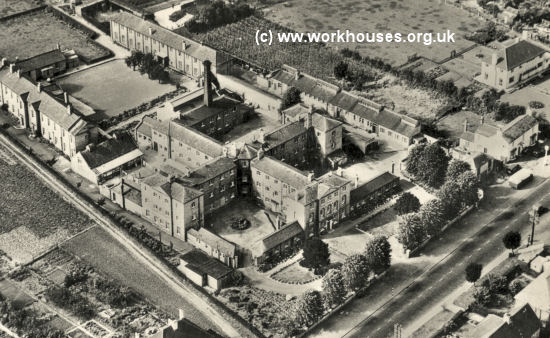
Biggleswade workhouse aerial view from the south-east, 1930s.
© Peter Higginbotham.
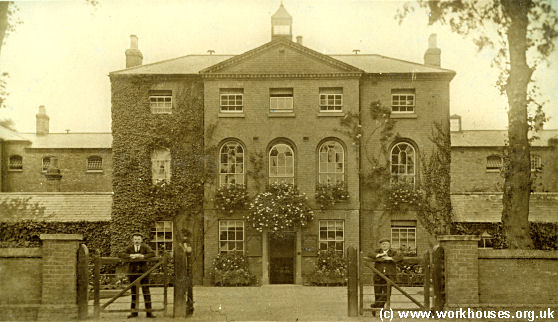
Biggleswade workhouse entrance from the east, c.1910.
© Peter Higginbotham.
Behind, four wings emanated from a central octagonal hub to provide separate accommodation for the different classes of inmate (male/female, old young etc.)
In 1841, a fever hospital was erected, followed by a larger infirmary in 1870. A new casual ward for vagrants was added in 1926. The workhouse location and layout can be seen on the 1924 map below (by which time the workhouse had become officially known as Biggleswade Poor Law Institution).
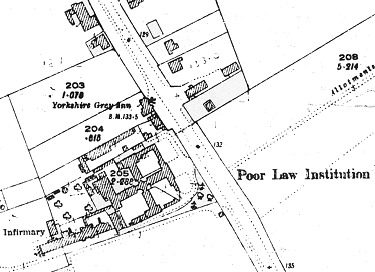
Biggleswade site layout, 1924.
On the afternoon of Wednesday 9 August 1843, one of the severest hailstorms ever recorded in Britain swept across the centre of England, beginning in the north Cotswolds then tracking north-east-by-east to pass over Norwich and then into the North Sea. The largest of the hailstones were over six inches in circumferences and weighed more than two ounces. At the Biggleswade workhouse, over 1,300 panes of glass were broken.
From 1904, to protect them from disadvantage in later life, the birth certificates for those born in the workhouse gave its address as Great North Road House. In the 1920s it was known locally as the Institution.
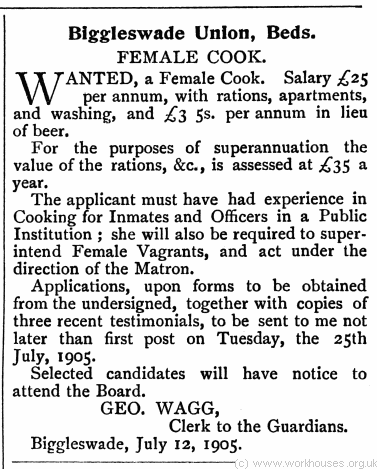
Biggleswade advertisement for cook, 1905.
© Peter Higginbotham.
The workhouse ceased operation in 1930 and its control was taken over by a local Public Assistance Committee. Its running was overseen by a new body though still called the Board of Guardians. The building, formally known as a Public Assistance Institution, provided accommodation for the aged and infirm and vagrants. In 1935, it was renamed The Limes. During this period, the Guardians had an ongoing debate about the serving of alcohol to residents with their Christmas dinner. In 1933, the vote was seven for and seven against. The chairman gave his casting vote against serving a glass of beer, and it was also decided not to purchase 18 gallons of lemonade or provide a cup of tea after their dinner. One member said that a cup of tea was unnecessary as they were each given a packet of tea. The master, who was overruled, said that they would much rather have ginger beer than tea. In 1935, for the first time in ten years, the Guardians voted by seven votes to five to serve a mug of beer with the Christmas dinner. They had beer again in 1936 and in 1937 an additional glass of beer for the Coronation.
From 1943 until about 1954, St Andrew's Maternity Hospital occupied part of the premises, after which it again became The Limes. It operated as an old people's home until its closure in 1969 when the occupants were moved to the new "Abbotsbury" residential home. The workhouse buildings demolished, amidst much local controversy, in 1972. The Biggleswade Chronicle reported that "No ceremony surrounded the demolition of the Limes. But many people will be rejoicing quietly that the building will soon be a heap of rubble."
Children's Homes
In around 1915, the union established a girls' home in a property known as 'Hillcote' on London Road, Biggleswade, just to the north of the workhouse. A home for boys was opened at 'Holmeside' on Station Road, Biggleswade. Each of the homes could accommodate twenty children. In 1930, operation of the homes was taken over by the Bedfordshire County Council, with 'Hillcote late being renamed ''Holmefield'.
Staff
Inmates
Records
Note: many repositories impose a closure period of up to 100 years for records identifying individuals. Before travelling a long distance, always check that the records you want to consult will be available.
- Bedfordshire and Luton Archives and Records Service, Borough Hall, Cauldwell Street, Bedford. MK42 9AP. . A variety of records survive including: Guardians' minute books and ledgers (1837-1930 with gaps); Ladies visiting committee reports (1893-1920); Admissions and discharges (1912-1930); etc.
- Ancestry
has Bedfordshire Workhouse and Poor Law Records (1835-1914) available online.
Bibliography
- Page, K. Biggleswade Workhouse in Bedfordshire Country Life Magazine, Summer 2003.
- Page, W. (ed.) (1908) Victoria County History of Bedfordshire, volume II
Links
Acknowledgments
- Thanks to Ken Page and Diane Oldman for information on Biggleswade.
Unless otherwise indicated, this page () is copyright Peter Higginbotham. Contents may not be reproduced without permission.


